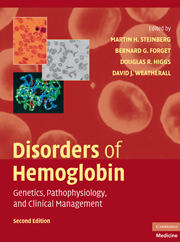Book contents
- Frontmatter
- Contents
- List of Contributors
- Foreword, by H. Franklin Bunn
- Preface
- Introduction, by David J. Weatherall
- SECTION ONE THE MOLECULAR, CELLULAR, AND GENETIC BASIS OF HEMOGLOBIN DISORDERS
- 1 A Developmental Approach to Hematopoiesis
- 2 Erythropoiesis
- 3 The Normal Structure and Regulation of Human Globin Gene Clusters
- 4 Nuclear Factors That Regulate Erythropoiesis
- 5 Molecular and Cellular Basis of Hemoglobin Switching
- 6 Structure and Function of Hemoglobin and Its Dysfunction in Sickle Cell Disease
- 7 Hemoglobins of the Embryo, Fetus, and Adult
- SECTION TWO PATHOPHYSIOLOGY OF HEMOGLOBIN AND ITS DISORDERS
- SECTION THREE α THALASSEMIA
- SECTION FOUR THE β THALASSEMIAS
- SECTION FIVE SICKLE CELL DISEASE
- SECTION SIX OTHER CLINICALLY IMPORTANT DISORDERS OF HEMOGLOBIN
- SECTION SEVEN SPECIAL TOPICS IN HEMOGLOBINOPATHIES
- SECTION EIGHT NEW APPROACHES TO THE TREATMENT OF HEMOGLOBINOPATHIES AND THALASSEMIA
- Index
- Plate section
- References
4 - Nuclear Factors That Regulate Erythropoiesis
from SECTION ONE - THE MOLECULAR, CELLULAR, AND GENETIC BASIS OF HEMOGLOBIN DISORDERS
Published online by Cambridge University Press: 03 May 2010
- Frontmatter
- Contents
- List of Contributors
- Foreword, by H. Franklin Bunn
- Preface
- Introduction, by David J. Weatherall
- SECTION ONE THE MOLECULAR, CELLULAR, AND GENETIC BASIS OF HEMOGLOBIN DISORDERS
- 1 A Developmental Approach to Hematopoiesis
- 2 Erythropoiesis
- 3 The Normal Structure and Regulation of Human Globin Gene Clusters
- 4 Nuclear Factors That Regulate Erythropoiesis
- 5 Molecular and Cellular Basis of Hemoglobin Switching
- 6 Structure and Function of Hemoglobin and Its Dysfunction in Sickle Cell Disease
- 7 Hemoglobins of the Embryo, Fetus, and Adult
- SECTION TWO PATHOPHYSIOLOGY OF HEMOGLOBIN AND ITS DISORDERS
- SECTION THREE α THALASSEMIA
- SECTION FOUR THE β THALASSEMIAS
- SECTION FIVE SICKLE CELL DISEASE
- SECTION SIX OTHER CLINICALLY IMPORTANT DISORDERS OF HEMOGLOBIN
- SECTION SEVEN SPECIAL TOPICS IN HEMOGLOBINOPATHIES
- SECTION EIGHT NEW APPROACHES TO THE TREATMENT OF HEMOGLOBINOPATHIES AND THALASSEMIA
- Index
- Plate section
- References
Summary
INTRODUCTION
Studies of erythroid transcription factors originate from efforts to identify and characterize the numerous tissue-specific and ubiquitous proteins that bind cis-regulatory motifs within the globin gene loci (Chapters 3 and 5). In addition to elucidating mechanisms of globin gene regulation and erythroid development, this approach has led to the discovery of nuclear proteins that function in a wide range of developmental processes. Experimental approaches and insights gained through studies of the globin loci have broad implications for understanding how transcription factors regulate the expression of individual genes and work together to coordinate cellular differentiation.
Erythrocyte formation in the vertebrate embryo occurs in several distinct waves (see also Chapter 1). The first erythrocytes, termed primitive (EryP), arise in the extraembryonic yolk sac at mouse embryonic day 7.5 (E7.5) and weeks 3–4 in the human embryo. Later, erythropoiesis shifts to the fetal liver where adult-type (EryD, definitive) erythrocytes are produced. Finally, at birth, blood formation shifts to the bone marrow, and also the spleen in mice. EryPs and EryDs are distinguished by their unique cellular morphology, cytokine responsiveness, transcription factor requirements, and patterns of gene expression. Most notably, the expression of individual globin genes is developmentally regulated (Chapter 3). Understanding how transcription factors regulate the temporal control of β-like globin genes during mammalian development is of general interest to the study of gene regulation in higher eukaryotes and could eventually lead to new approaches to reactivate the human fetal γ-globin genes in patients with β chain hemoglobinopathies, such as sickle cell anemia and β thalassemia.
- Type
- Chapter
- Information
- Disorders of HemoglobinGenetics, Pathophysiology, and Clinical Management, pp. 62 - 85Publisher: Cambridge University PressPrint publication year: 2009
References
- 2
- Cited by



